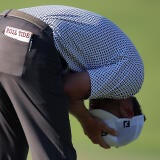2017 U.S. Open: Breaking down the course, field, setup and an early prediction
Who are the favorites, what is the course like and how will all of this play out next week at Erin Hills

The 2017 U.S. Open at Erin Hills starts in a week as the summer major season sets in on the professional golf world. Tiger Woods and Phil Mickelson will be absent (definitely on the former, probably on the latter), which means the old guard will be fully away from a major championship for the first time in over two decades. Neither was likely to win, but metaphorically speaking, this is significant.
A new golf era has been ushered in, and it will be on full display at Erin Hills. We will get deeper into the weeds (literally!) of how this tournament will play out next week, but for now let's take a high-level look at the 117th United States Open.
The course
Built on the farmland of central Wisconsin, Erin Hills is a new track that looks old. It has a Scottish feel with an American twist and is demanding even in non-U.S. Open conditions. Many have compared it to Chambers Bay, site of the 2015 U.S. Open.
"Chambers Bay, you had big mounds to play off onto the greens," 2015 U.S. Open champion Jordan Spieth said last week at the Memorial Tournament. "[Erin] is kind of rolling hills. Although, neither one has a tree that I remember on the golf course. It was kind of a new-style American Links type. They both are. But I think they'll play tremendously different."
The course didn't open until 2006, but it looks as if it has been there since about 1906. The backdrop for the nation's championship will be stunning. The natural landscape and perfectly-manicured greens and fairways make for a staggering beauty in the heart of the country. Gary D'Amato recently released a six-part series on the making of Erin Hills, and it is definitely worth your time.
The course can play up to 7,800 yards with a closing hole that can sit nearly 700 yards from glory. The walk at Erin will be long and treacherous, and it will probably be a championship that is better viewed from your couch than on the grounds. But still, the view on the grounds will be magnificent.
"We had great drama at Chambers Bay," course architect Robert Trent Jones Jr. told Golf Digest. "I'm hopeful Erin Hills has the same drama. I've played Erin Hills and I think it's a wonderful golf course. I'm very much an Erin Hills supporter. After all, three golf architects designed it, not professional golfers. Michael Hurdzan, Dana Fry and [Golf Digest architecture editor] Ron Whitten built it.
"It's a great new treasure of golf for the midwest."
The field
The usual suspects are atop next week's favorites.
- Dustin Johnson: 6-1
- Rory McIlroy: 9-1
- Jordan Spieth: 10-1
- Jason Day: 11-1
- Jon Rahm: 16-1
We have gotten pretty elite champs in each of the last four years. Justin Rose, Martin Kaymer, Jordan Spieth and Dustin Johnson are your last four national champions. I expect nothing different this time around, though the long-shot qualifiers and amateurs involved always make for tremendous stories.
This year's batch includes reigning U.S. Mid-Am champion (and low am at the Masters) Stewart Hagestad, Wisconsin native Steve Stricker, high schooler Walker Lee, Bryson DeChambeau and former U.S. Amateur champion (at Chambers Bay!) Peter Uihlein.
Last year little-known Andrew Landry stole the show early in the week before fading late. Who will it be this time around at Erin Hills?
The setup
There will always be someone critical of a U.S. Open setup, but the past two years have been particularly hairy. Chambers Bay in 2015 was a borderline disaster with greens that looked like they were imported from another planet. Last year at Oakmont, conditions were firm enough to create yet another controversy with Dustin Johnson and his golf ball.
This time around, Adam Scott has a suggestion.
"[The USGA has] taken criticism for the last two years, I'm sure they're not liking it," Scott told Golfweek recently. "They're going to have to try to run a really good event. The ball is in their court; they control it all. Hopefully they get it right this time, just from a playability standpoint. Let's just have something that's a challenge and interesting, not just playing brutal [golf]."
The unwritten rule of U.S. Opens, of course, is to keep the winning score at or around par. I'm not positive this is actually the case as the last three winners have all been 4 under or better. I think the USGA gets unfairly criticized much of the time, but Scott is right about the test. The line between "tricked up" and "as challenging as the Johnson brothers competing in a math bowl" is so thin. The USGA tends to sometimes error on the tricked up side of things which is unfortunate because it creates a scenario in which the course and the organization becomes the focal point instead of the players.
Hopefully, they'll get it right this time around.
The (early) prediction
I haven't released my official pick for the tournament, but I've been leading toward Dustin Johnson for the past few months. His missed cut and -6.9 strokes gained with the putter at the Memorial Tournament last week are mildly worrisome, but a long, demanding course like Erin Hills is going to summon a 72-hole horse.
In so many ways, as he proved at Oakmont last year, Johnson is built to pummel into submission monstrous tracks like the ones the USGA has been choosing for its championships recently. I don't know if he'll win, but it's difficult for me to think that, barring a complete and total collapse on the greens, Johnson won't at least be in the hunt on the weekend.
Had a good couple of practice rounds at Erin Hills and really like the course. Looking forward to defending next week.
— Dustin Johnson (@DJohnsonPGA) June 5, 2017

















